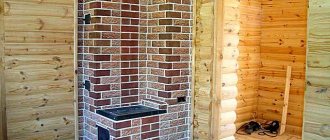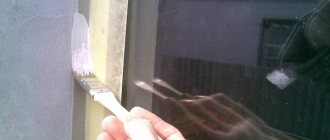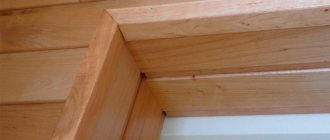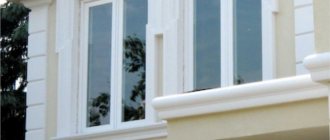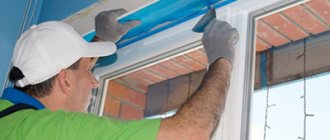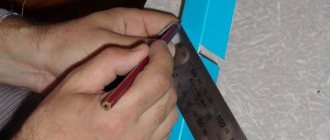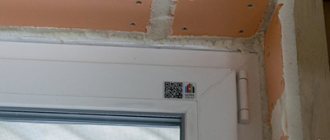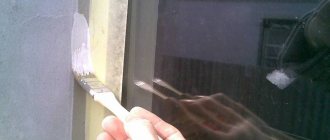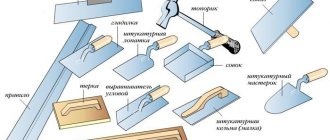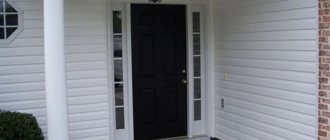How to choose the right tile
To make the right choice and finish the slopes with such material, you need to take into account several basic criteria:
- purpose of the premises;
- sanitary condition;
- design;
- the desire of the owner of the room.
For example, in the kitchen you should not decorate with artificial stone. Its uneven surface will be difficult to clean. This material is more suitable for a living room with a corresponding design.
Laying tiles most often occurs in rooms with high humidity. Finishing door slopes in such rooms helps to obtain the desired interior and design.
Decorative textured slopes with stone-like tiles
Door trim
You can decorate the perimeter of the door opening and slopes with ceramics. Moreover, the type of tile will play a major role. Imitation of walls and brick slopes is done with special tiles. It is usually based on cement, which is mixed with additional fillers and various dyes.
You can lay textured material for finishing slopes yourself, without the help of specialists. This work does not cause any difficulties, since it does not require leveling the surface. The use of special corners eliminates the need to join external corners.
Finishing window and door slopes with ceramic tiles
Korovin Sergey Dmitrievich
Master of Architecture, graduated from Samara State University of Architecture and Civil Engineering. 11 years of experience in design and construction.
Finishing slopes with ceramic tiles is relevant for rooms with high humidity - where this material is most often used for cladding walls and floors: in bathrooms, toilets and kitchens. Tiles on window slopes will perform not only a decorative function, but also a practical one - in quality it can be compared with natural or artificial stone.
Description of material
In the interiors of living rooms you can find openings decorated with mosaics - it always looks unusual and bright. This interior is distinguished by individuality and special beauty. The tile can be ceramic or figured, imitating artificial stone.
Ceramics
Decorative ceramic tiles can be used to decorate the slopes of windows and doors in the bathroom and kitchen. Due to its high hygienic qualities, this material is used for kitchen aprons.
Ceramic tiles are highly durable
Ceramics has many positive qualities:
- strength;
- high wear resistance;
- durability;
- minimal water absorption;
- hygiene;
- it does not allow electric current to pass through;
- fire safety;
- environmental friendliness;
- affordable cost;
- decorativeness and a wide selection of colors, shapes and sizes.
Tile
Tile is a type of ceramic, from which it differs in its durable glossy glazed surface. The cost of these products is higher than ceramic ones, but their service life is measured in decades.
The tiles are resistant to temperature changes
- has high strength;
- is resistant to chemicals and alkali;
- withstands temperature changes and exposure to direct sunlight;
- retains its appearance and quality throughout the entire operational period;
- waterproof;
- easy to care for and has a high level of hygiene;
- has a wide range of colors, patterns and shapes;
- common and affordable.
Stone effect tiles
This finish perfectly imitates masonry made of any natural and artificial stones. This material is based on fusible clay and quartz sand. Thanks to this, the products are lightweight, unlike ceramics and tiles. Finishing windows with such tiles will avoid excessive load on the window opening. In a private house, external slopes can be finished with this material. You just need to choose products for external cladding work.
The tiles on window slopes with imitation stone are different:
- light weight;
- various surface options - textured, matte, glossy;
- compactness;
- simple installation and ease of processing;
- can be used when finishing a door arch is required;
- firmly fixed to tile adhesive.
Products that imitate old masonry are expensive. This must be taken into account when choosing material.
Mosaic
Window decoration with ceramic mosaics looks unusual and original. With its help you can make interesting doorways in living rooms.
The most original way to finish slopes is mosaic
This type of window decoration is made using small ceramic elements, from which a strict ornament or a chaotic pattern is formed.
Slopes made of ceramic tiles under stone
You can make slopes made of tiles that imitate masonry made of natural or artificial stone for windows and doors with your own hands.
You can trim the slopes with tiles yourself
Before starting work with this material, you do not need to level the surface. This material is convenient because in addition to flat elements, you can purchase corner parts to make the opening look neat.
- To achieve high-quality adhesion between the product and the surface of the slope, notches are made on the latter.
Notches on the slope improve adhesion. Slopes are primed.
Primer of the slope surface The adhesive solution is applied not to the wall, but directly to the product.
The solution is applied to the tiles. Lay the tiles starting from the corner. When laying, the masonry elements are pressed tightly against each other, leaving no seams. If there is a desire to have seams, then plastic pegs are inserted between the parts.
To form a seam, pegs are inserted between the tiles. The seams are filled with grout mixture using a construction syringe.
The seam is filled with grout
- The grout is distributed along the seam using a brush.
To trim some of the fragments connecting to the window frame, you can use a regular hacksaw. At the ends, the tiles can be laid freely.
Slopes made of tiles or ceramic tiles
If it is necessary to finish the slopes of windows or doors with elements with precise geometric dimensions, you must follow the instructions given below.
Laying
Before starting work, the slopes must be carefully leveled. The tiles will be laid with high quality only on a smooth, flat surface. This must be controlled using a building level.
There are several methods for leveling slopes: using plaster, drywall or chipboard.
You can line the window opening with plasterboard
Below we will tell you how to lay tiles on a previously plastered and primed slope.
Laying technology
- For better adhesion to the adhesive solution, notches are made on the surface to be coated.
- Door slopes are covered with soil.
- Glue is applied to the surface of the ceramic. It must comply with the manufacturer's recommendations.
- The tile must be glued horizontally. You need to start from the corner, fitting each piece tightly so that there are no seams.
- A regular hacksaw is suitable for cutting.
- Excess glue is removed with a rag.
When doing this type of trim, you usually only have to trim the part that fits into the window frame. On other planes it is laid out in a chaotic manner. You may even end up with an uneven end.
Leveling slopes with plasterboard for tiles
Flaws
For all its advantages, this material has several disadvantages. Firstly, it is high cost. Secondly, laying tiles requires certain skills and knowledge. This facing material requires great care and a lot of time when working. However, the resulting result always compensates for all the disadvantages with its attractive appearance and reliability.
Slopes made of ceramic tiles for the entrance door opening
Description of material
Often, owners of private houses resort to decorative window openings with ceramic tiles. The design move is a continuation of the interior decoration. The most common place where the technique is used is the kitchen. Several types are used - glossy, matte, stone-look tiles, mosaic.
Glossy
It is distinguished by its attractiveness and stylistic design. Gloss transforms the window.
Gloss
Advantages
Regardless of the window opening, wide, narrow, glossy cladding material looks good:
- The reflective coating gives a mirror shine, visually expanding the window opening.
- Practically does not absorb moisture.
- Repels dirt and water. Easy to clean, no powder cleaners required.
Flaws
Daylight reveals the slightest dirt. The factor creates other disadvantages of the product:
- If there is a little dusting, you have to pick up a rag and wipe off the dust. If streaks or smudges appear, remove them using gentle means.
- High degree of light reflection. Reflected glare can blind the eyes; it is not recommended to locate dining areas near the window opening.
Matte
Gives the window opening elegance. The material has practically no disadvantages; its advantages make the decorative coating popular.
Matte
Advantages
Advantages:
- The matte surface does not reflect sunlight; you can place a dining area near the window.
- The surface is rough, practically no moisture collects.
- The appearance of dust is not noticeable; preventative cleaning must be carried out twice as often. Abrasive cleaners do not leave scratches.
- Even if small scratches appear, they will not be noticeable, and the tile will not lose its attractiveness.
Flaws
Flaws:
- The lack of a reflective surface makes the matte finish unable to expand the space. When placed in a small window opening, it will visually make it even smaller.
- There is no water-repellent layer - gloss, the product is more sensitive to moisture.
- Greasy, limescale deposits are difficult to remove.
Mosaic
The mosaic tile finish looks unusual, somewhat original. This type of design is used when lining doorways. You can create ornaments and chaotic patterns.
Mosaic
Advantages
Mosaic is wear-resistant and durable. It will not lose color, attractiveness, or begin to fall off. Tolerates exposure to direct sunlight well. The product consists of small squares and is flexible.
Flaws
The tiles are made from natural materials, expensive. Cheap analogues are made from artificial ones.
Slopes made of ceramic tiles under stone
You can make slopes made of tiles that imitate masonry made of natural or artificial stone for windows and doors with your own hands.
You can trim the slopes with tiles yourself
Before starting work with this material, you do not need to level the surface. This material is convenient because in addition to flat elements, you can purchase corner parts to make the opening look neat.
- To achieve high-quality adhesion between the product and the surface of the slope, notches are made on the latter. Notches on the slope improve adhesion
- The slopes are primed. Primer of the slope surface
- The adhesive solution is not applied to the wall, but directly to the product. The solution is applied to the tiles
- Laying tiles begins from the corner. When laying, the masonry elements are pressed tightly against each other, leaving no seams. If there is a desire to have seams, then plastic pegs are inserted between the parts. To form a seam, pegs are inserted between the tiles.
- The seams are filled with grout mixture using a construction syringe. The seam is filled with grout
- The grout is distributed along the seam using a brush.
To trim some of the fragments connecting to the window frame, you can use a regular hacksaw. At the ends, the tiles can be laid freely.
Possible mistakes
- When laying panels or drywall, it is important to accurately measure the depth and height of the slopes. Then the finish will fit smoothly, leaving no gaps or unfilled spaces.
- It is also important to ensure that the finishing is strictly vertical (from the sides) and horizontal (from above). A laser or bubble level will help with this. It’s easy to correct defects at the installation stage, but doing so later will be more difficult.
- Another common mistake is using too thick a layer of plaster. It will crack over time, and everything will have to be redone.
Mosaic slopes
To install a mosaic covering on the slopes of windows and doors, you can use special soft canvases on which ceramic pieces are glued. The base can be paper or in the form of a mesh. Their convenience lies in the fact that you can cut the canvas to the required size.
The installation process is simple. The surface of the slope must be dry, clean and level. At the preparatory stage, preliminary markings are made on the slope, according to which the mosaic canvas is then glued.
- the glue is applied with a notched trowel;
Use a notched trowel to apply the glue. - When gluing the mosaic canvas, you do not need to put too much pressure on it so that the adhesive does not squeeze out through the seams;
It is necessary to glue the mosaic canvas without strong pressure - It is recommended to use epoxy resin-based grout for sealing joints;
Epoxy resin is used to grout joints - Using a rubber spatula, spread the grout in an even layer;
To distribute the grout evenly, use a rubber spatula - After the grout has dried, its excess is removed with a damp sponge.
Window and door slopes, finished with one of the listed materials, will decorate any interior and retain their original appearance for many years.
Opening type
It’s clear why the opening needs to be sheathed, but not all of them are standard; there are many options. Coming out of this, the finishing materials also differ. Options:
Rectangular opening. Sheathed with any material, including plastic panels
Moreover, it can be not just a place of passage to another room or into the house, but an important part of the design solution of the room. Arch. This option is not used in every room, as it is appropriate only in some styles
This solution is suitable if the rooms are decorated the same way and there is no need to physically separate them. For finishing, you should choose materials that do not stand out too much from the background of the rest of the room, otherwise they will “weight down” the opening. It is interesting that in modern interiors, in addition to classic rounded arches, ellipsoidal, trapezoidal, and even asymmetrical arches are created. They can be easily finished with plastic panels, which cannot be said about tiles.
- Imitation of an arch. This method is also called lazy, because an “arched” finish is formed in an ordinary rectangular opening; it will not be difficult to complete.
- A doorway without a door. It’s easiest to install the finishing here, but the main task in this case is to choose the right material, then the finished opening will look organic.
Slope finished with plastic panels
Do-it-yourself finishing of window slopes with clinker tiles
- Clinker tiles are a special type of ceramic tile fired at temperatures above 1200°C. It has enormous strength, as well as a varied texture and a wide range of colors. Slopes and other surfaces lined with this material are reliable, durable and have a beautiful appearance.
- How to make window slopes with your own hands, using clinker tiles, and without hiring hired craftsmen? First of all, you need to understand that clinker is a material for external cladding, so here we will talk about external window slopes.
So what do we need?
- Clinker tiles
- Glue
- Cutting tool (grinder, cutter, file)
- Ruler and carpenter's pencil
- Level
- Special corners (if used)
- Glue spatula
How to perform cladding?
- Take all measurements carefully and mark them on the tiles and wall.
- Start working directly from the slopes, then line the internal corners.
- To make the corner look beautiful, they use the chamfer method, when they cut the corner inside the tile at 45 degrees. This work requires special care and precision; thicker material is selected for it.
- You can avoid chamfering, glue the tiles end-to-end at the corners, and then use special corners that will provide an excellent appearance. This method does not require such high precision of laying and cutting, but you have to spend more on material - those same corners.
- Gluing begins from the outer corners, then the inner corners are glued, and then the even areas. It is advisable to select glue and clinker tiles from the same manufacturer.
- Carry out the work carefully following the instructions on the glue packaging.
Window and façade cladding.
Can be decorated both outside and inside . Important points:
- Before laying clinker, the slopes must be carefully leveled - plaster, use plasterboard or chipboard, and prime the surface.
- Work can be carried out if the outside temperature remains between +5 and +30°C.
- Cladding should not be carried out during rain.
- The adhesive should be applied with a notched trowel in a continuous layer. The height of the trowel ridges should be 6-8 mm for light tiles, and 10-12 mm for heavy ones.
Installation of panels: preparation
Preparation consists of studying the technology of work behavior:
- The first step is to clear the opening from any remaining finishing.
- Next comes plaster. This step is optional, but it makes it easier to install the panels; provided the alignment is good, you can do without lathing.
- Coating with a primer to prevent the development of fungi and mold under the panel, since it cannot be dismantled without losing its integrity.
- Next, the sheathing (if necessary) and PVC panels are installed.
Tools and materials that will be needed for work:
- Level.
- Electric drill or screwdriver.
- Self-tapping screws.
- Hand saw or jigsaw.
- Pencil.
Wood-look PVC slopes
Installation of sandwich panels
Such panels protect the doorway from the cold thanks to their multilayer structure. It contains foamed polystyrene with a closed cell structure, externally it is protected by a special rigid PVC film. Such panels are durable and resistant to ultraviolet radiation. They can be used to cover door slopes of any thickness - from 5 to 150 cm.
The panels are installed using dowels. The ends are closed with decorative corners. The joints with the box must be treated with a sealant of a suitable color.
Wall panels: installation
This material is also used for cladding, but wall panels are more fragile, so you need to handle them carefully. They are available in different lengths and widths. Mounted on a sheathing made of metal or wooden blocks. To improve heat and sound insulation performance, it is worth laying insulation on the slope. A decorative corner is installed at the joints.
Multi-colored plastic panels
How to work with a tile template
Tile adhesive is immediately applied to window slopes in a small layer (about 4-5 mm) without prior plastering. First we apply tile adhesive to the base, and then apply it to the tiles.
Using a special handle with suction cups, you need to move the tile up and down several times so that the tile adhesive fills the space under the tile as efficiently as possible.
You can watch the video below for details on how to lay tiles on slopes using a template. This review was created based on the author’s video from YouTube channel 9 plitok.
Sequence of work
You need to start laying tiles on the side surfaces. Moreover, only whole tiles should be used. Work continues until the horizontal row is above the upper end of the opening.
A flat strip is attached above the opening. The top edge of the plank should match the line that connects the bottom edges of the entire tiles above the opening line.
When the laying of solid tiles is completed, you can begin tiling near the slopes with additional pieces. Work should start from the bottom point. It is very important that the edge tiles are cut at an angle. You'll have to use a grinder.
After this, the facing of the side planes begins. During the work, the glue on the top will set well. You can remove the support bar. All that remains is to close the consolidated space remaining above the door.
Tiling door slopes in the bathroom
DIY window slopes made of ceramic tiles
This method is similar to the previous one, because the properties of ceramic tiles (tiles) and clinker are quite similar. But there are also significant differences.
First of all, ceramic tiles:
- Durable
- Wear-resistant
- Does not absorb water
- Hygienic
- Not flammable
- Eco-friendly
- Inexpensive
- Beautiful, multicolor
It is the glossy, multi-colored, glazed surface that is the main difference between tiles and clinker.
Decoration with tiles
The technology for decorating window slopes with ceramic tiles is similar to the technology for laying clinker tiles:
- The slopes are carefully leveled by plastering or sheathing with plasterboard, after which they are carefully primed.
- All measurements are carefully taken and the surface of the slope is marked according to them. It is especially necessary to ensure that the height of the tiles on both vertical slopes coincides, and the seams between the tiles are at the same level.
- The glue is diluted according to the instructions for use and applied to the slope.
- The tiles are laid out starting from the first bottom row, from the corner.
- Corners can be glued end-to-end, first removing 45 degrees of chamfer, but thin tiles simply require jeweler's precision, and a good result is not always obtained. Therefore, it is better to use special corners. They will ensure precise styling and a beautiful appearance.
- The laying of each row is controlled by a level, and equal distances between the rows and tiles in them are achieved using special cross-spacers
- After the glue has completely dried, the seams are rubbed using white cement and fine-grained sand. Instead of cement, you can use finishing putty and add a coloring compound to add color.
- After the grout in the joints has dried, the surface of the tile is wiped with a wet cloth or washed.
Ceramic cladding
When it is necessary to clad only one doorway, and the walls are lined with a different material, the door slopes are faced with ceramic tiles in a miter pattern.
The slopes are carefully leveled. All surfaces must be level. You can use a building level to check.
Surface leveling is done using different materials:
- drywall;
- plaster;
- chipboard;
- DSP;
- OSB.
Plastering slopes: preparation for laying tiles
Original do-it-yourself window slopes from mirrors
To decorate window slopes with mirror materials, you can use not only tiles with a mirror surface, but also entire mirrors according to the size of the slope. This cladding creates the effect of expanded space, an endless path of images on both sides of the window. Mirrors are cut out yourself or mirror panels are ordered according to individual cutting, strictly corresponding to the dimensions of the slopes - the top and two side surfaces.
To increase space
- For gluing, liquid nails, sealant or amalgam glue are used.
- The glue is applied to the back side of the panel and to the surface of the slope, the mirror is placed at the attachment point, pressed and the glue is allowed to set.
- All work must be carried out extremely carefully and carefully, since if the fragile mirror bursts, you will have to cut it out or order a new panel; a cracked one can no longer be repaired.
- If you need to support the panel with supports, be sure to protect the outer mirror layer from scratches with a soft material.
- If necessary, the joints are covered with a decorative strip.
Decorative plaster
A variation of point No. 2. “Decorative” is applied to a previously plastered surface. If the decorative plaster is textured, then the rough layer does not need to be laid out perfectly evenly. You can choose plaster with colored stone chips - it is very durable.
The disadvantages are the high cost of materials, labor-intensive and “dirty” work.
Frame from youtube.com
The adjacent wall can be wallpapered, painted or decorative plaster applied to it.
Frame from youtube.com
Do-it-yourself finishing of window slopes with mirror tiles
- This method of finishing window slopes is used when they want to visually enlarge a small room, give it more light, and “break” the usual rectangular space.
- Unlike solid mirror slopes, which are made from panels to fit the size of the window and create the effect of visually enlarging the space, mirror tiles create many facets, which is why an ordinary window seems like a fairy-tale crystal.
- In general, glass on slopes looks very beautiful and expensive, but subject to one important condition. It must be wiped daily with a rag and washed regularly with special detergents.
Beautiful mosaic for windows
Features of working with mirror tiles for window slopes:
- This tile differs from ordinary tiles in its smaller thickness, greater fragility and special delicacy of the top mirror layer. Working with it cannot be rushed and requires special care and increased attention. Such tiles are mounted using tile adhesive specially designed for this purpose, neutral sealant, and liquid nails.
- Do not use cement mortar or conventional sealant that contains vinegar.
- First of all, we select tiles by size. Cutting it is quite difficult, so it is better to immediately choose the optimal size to reduce the number of cuts to a minimum. The range of such tiles is very diverse in size.
- We carefully level the slope surfaces. Any tile requires leveling, but in this case this work must be done with special care, avoiding the slightest unevenness.
- We prime the slope with a special primer.
- We make very careful markings, making marks on the surface of the wall and on the tiles.
- If there is a need for cutting, we use only high quality diamond glass cutters.
- The tiles prepared for gluing should be placed vertically, leaning against a support, to avoid scratches on the mirror surface.
- The glue is applied to the back side of the tile, then it is applied to the installation site according to the marks, and pressed for a few seconds
- It is necessary to leave a gap between the tiles, which is achieved with special cross spacers.
- At the corners, beveled tiles are fitted end-to-end, forming an edge.
- After the glue has completely dried (usually after a few days), the joints should be grouted.
- The best material for this is neutral silicone, which is used to fill the seams, and the residue is removed with a rubber spatula and a damp cloth.
A few nuances
In order for the finishing of door or window slopes to take place without unpleasant surprises, several conditions must be observed, the main one of which will be high-quality preparation of the working surface. The base on which the coating is to be laid must be as smooth as possible and free from significant flaws. In bathrooms and other damp places in the house, you will need to pre-treat the base with various impregnations or primers to create additional protection from moisture.
Since in most cases design elements will have to be cut anyway, it is better to practice in advance on unnecessary fragments or simply ask a more experienced craftsman to do the work. Without experience, it is difficult to obtain a high-quality result, and if you don’t have it, you can choose a coating that does not require trimming parts. This can be like finishing with gypsum tiles, which can be easily sawed with a regular hacksaw for metal, or mosaics in general, which practically do not require any adjustment in size.
Savings in the case of such difficult-to-work material results in a very low-quality result. The photo below shows what finishing slopes with tiles can look like with an amateurish approach. Everything looks sloppy and does not add beauty to the design of the room. To avoid such results, contact an experienced technician if you have never performed such repairs yourself.
